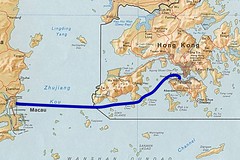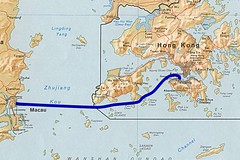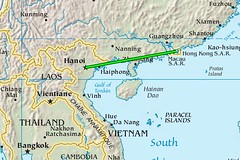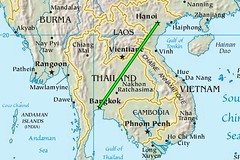Doin' China, Days 1 and 2
Yesterday our grand tour of China began. Our guide, Mae, met us in reception at 09:30 and we went outside to a waiting MPV. We went first to Shanghai Museum which is a traditional museum with artefacts in glass cases. They're beautifully lit and presented, but unless you have a particular interest in multi-thousand year old bronze vessels there are only so many you can look at in one day. Mae was not allowed to provide a commentary inside the museum so she gave us radio handsets to get the museum's own information. We managed to do reasonable justice to the bronze, furniture, currency, calligraphy and writing seal galleries.
The next destination on our itinerary was The Bund. The word Bund sounds German (to us), but Mae told us that it's a Hindi word meaning 'embankment' and it's pronounced like 'sticky bun' with a 'd' on the end. If you don't speak German that's probably the way you pronounced it in your head when you read it anyway! On our side of the Huangpu River we had a good view across to the Pudong area with its fantastic modern skyline, and behind us of the old colonial-era buildings, mostly banks and hotels. They say in Shanghai that you can see the architectural style of every European country in this part of the city.
Twenty years ago the only way to cross the river was by ferry. No one wanted to live in Pudong if they worked in the main part of Shanghai because the commute was slow. Now there are bridges and a subway, not to mention the tourist tunnel [was that a dream?], and Pudong is thriving. After this, Mae seemed to run out of things to tell us and suggested we go for lunch. We went to a local hotel and were shown to a table laid for four. We were expecting Mae to join us and were looking forward to finding out first hand how to use chopsticks, which food to put in which bowl at which time, and resolve all those little details that might stop us from generally making a scene. We sat down and were disappointed when the staff cleared away the crockery from two of the place settings. Mae said she would see us later—she would be eating elsewhere in the restaurant. We were going to have to figure it out by ourselves.
Some food came. Then some more came. Then some more. Luckily it stopped before the table collapsed. There was enough to feed a dozen people, and when we were completely full many of the dishes looked like they hadn't even been touched. It was embarrassing, but we couldn't eat any more—not even a wafer thin mint.
With lunch over (if not finished) it was time for the 'visit a local family' slot. We drove across town and ended up at a community centre for use by retired people. Here we were briefly shown an array of wonderful things provided for the retired people, such as gym equipment, libraries, computer rooms, art studios, chess rooms etc. There was even a small souvenir shop for the tourists. We were joined by an official guide and it seems that a family was allocated to us at that time, as Mae was as much in the dark as we were. We drove a couple of blocks with the official guide also in the car, to a nearby housing estate. We went to a ground-floor apartment and rang a doorbell. The metal-grilled door was opened by Mrs Wu. She ushered us in and we all sat down around her dining table. Mae and the official guide gave us little bits of information about life in Shanghai and we managed to have some sort of conversation with Mrs Wu via Mae. Then we had a quick look around. Grandma lives in the back room, Mr and Mrs Wu sleep in the living room, beyond which is their teenage son's room. There was also a bathroom and kitchen. We said things like 'you have a very nice home' and 'thank you for letting us come to see you' and we left. It was a strange experience. We wondered just what the arrangement is here. Certainly there are only a select number of families whom foreigners are permitted to visit.
Back in the car, Mae talked about how housing works in Shanghai. Local people (native Shanghainese) used to be provided with a house or flat by the government, but had no say over where it was. Now in the market economy, they can get a subsidised home with a shared-ownership scheme and a very low-cost government loan—and so they have a say over how much they are willing to pay and where the accommodation is. If non-Shanghainese people want to live in the city they can, but they get no help with the cost of their accommodation. Of the 20 million people in Shanghai, 14 million are Shanghainese. Shanghai is a very popular place to live and work so parents nationwide want their daughters to marry a Shanghainese boy.
Next up was the Yu garden in the old part of the city. Designed and built in the sixteenth century by government official Pan Yunduan for his parents, the garden took so long to complete that both parents had died before it was finished. Bet he never thought that 430 years later his garden would still be delighting visitors. It was beautiful and very cleverly designed, such that it feels huge even though it is fitted into quite a small space.
We returned to the Pacific Luck for a break for a few hours. It wasn't very far to go—by subway and foot it would have taken about 15 minutes, but stuck in the Shanghai traffic it took 45 minutes. We learned that Shanghai has three rush hours a day: the morning one from 06:00 to 12:00, then the lunchtime one from 12:00 to 14:00, and the evening one from 14:00 until at least 21:00.
Our tour itinerary included a "memorable dinner" at the Central Hotel, whose restaurant Wang Bao He has a history of around 260 years and is apparently the best place in town to enjoy Shanghai cuisine. It was indeed excellent—we had some really delicious pork dumplings, but we were still so full from lunch that we only spent half our 300 yuan budget. We finished off the first day with a visit to the Portman Acrobatic Show at the Lyceum Theatre. The acrobats were incredibly talented. Our money will be on China doing well in the gymnastics at next year's Beijing Olympics.
We had this morning free, and there was just one more thing that we wanted to see before we caught the overnight train to Huangshan. Shanghai boasts the world's only commercial MagLev (magnetic levitation) train, running from Longyang Road subway station out to Pudong Airport. For 80 yuan (GBP 5.24 / USD 10.35) for a return ticket you can make the 32 kilometre journey in just over seven minutes, peaking (briefly) at 431 km/h (268 mph). It's currently the world's fastest in-service ground-based transport. We now understand how the people who travelled on early trains in the nineteenth century must have felt, when they were used to moving around at walking pace. The feeling of speed is further enhanced by the fact that you run most of the way right next to an expressway, passing the cars as if they are standing still. But it's still an incredible 150 km/h slower than the MagLev world record set in Japan on a test run. Yes, of course we made a video! See below. At the start of the clip we are doing maximum speed but we soon start to slow down because we are getting close to the airport. At 1 min 06 sec we pass another train at a combined closing speed of over 700 km/h. The other train is five carriages long but it passes in a flash—don't blink or you will miss it.
There happened to be a convenience store at the airport, so as we're on another overnight train tonight, we bought some food for breakfast tomorrow morning. Then we caught the MagLev back into town. Surely this had been the world's fastest trip to a grocery shop.
OK, so we've only seen China's most advanced city so far, but based on this evidence there is little doubt that the future is going to be led by China. The Chinese just decide what they want to do, and then they go and make it happen. Flatten an entire district of a city and turn it into an international financial centre? No problem, let's do it. Western domination of the world is over and we had better start getting used to it.

![[IMG_1769]](http://farm1.static.flickr.com/163/437648564_07ff71290a_m.jpg)
![The largest model of a city in the world. The model occupies an area of over 100 square metres and is in 1:2000 scale. [IMG_1690]](http://farm1.static.flickr.com/180/436398654_f76fed7e48_m.jpg)
![A very strange train ride under the Huangpu River. [IMG_1698]](http://farm1.static.flickr.com/188/436408803_a42929a344_m.jpg)
![The floors below are the Grand Hyatt hotel, occupying the 53rd to 87th floors. The lobby is visible at the bottom. [IMG_1710]](http://farm1.static.flickr.com/184/436416136_05efe72d8d_m.jpg)

![[IMG_1669]](http://farm1.static.flickr.com/171/436385783_cfb7236ad4_m.jpg)


![[IMG_1668]](http://farm1.static.flickr.com/147/432437142_580dbc231d_m.jpg)

![[IMG_1626]](http://farm1.static.flickr.com/168/432422054_143968fc12_m.jpg)

![[IMG_1486]](http://farm1.static.flickr.com/162/422997433_2274b0ec0e_m.jpg)
![[IMG_1568]](http://farm1.static.flickr.com/177/428109534_cca84893d7_m.jpg)
![[IMG_1592]](http://farm1.static.flickr.com/165/428124364_6a288be53a_m.jpg)


![[IMG_1477]](http://farm1.static.flickr.com/126/422949068_8623389a40_m.jpg)
![[IMG_1478]](http://farm1.static.flickr.com/131/422953175_9bf9384568_m.jpg)
![[IMG_1395]](http://farm1.static.flickr.com/155/422939279_f2f6dc8330_m.jpg)
![[]IMG_1473](http://farm1.static.flickr.com/155/422949039_80891e42f2_m.jpg)

![[IMG_1385]](http://farm1.static.flickr.com/123/418445860_7aeab28aa0_m.jpg)
![[IMG_1479]](http://farm1.static.flickr.com/147/422953185_8438d5557c_m.jpg)

![[IMG_1377]](http://farm1.static.flickr.com/160/415174390_1e1658672a_m.jpg)
![[IMG_1369]](http://farm1.static.flickr.com/185/415141123_e6bedf5870_m.jpg)
![[IMG_1360]](http://farm1.static.flickr.com/146/415141114_f7eab83c23_m.jpg)
![[IMG_1337]](http://farm1.static.flickr.com/164/408515056_3591d3ea0c_m.jpg)


